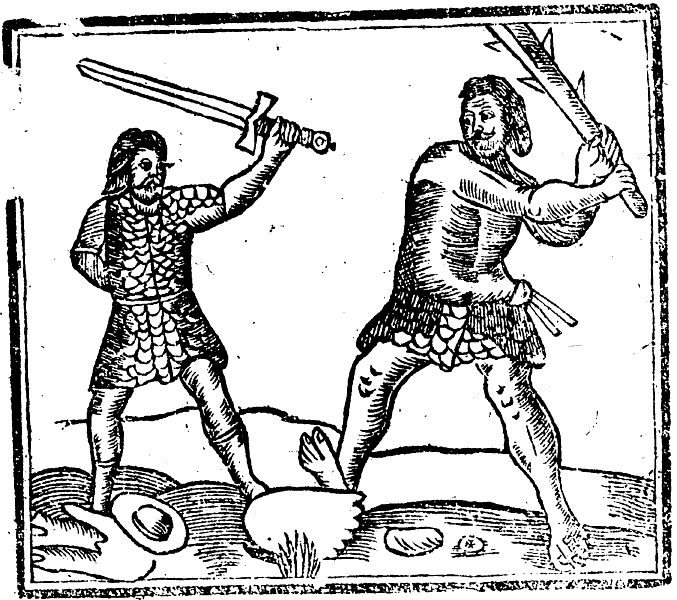|
Guy Of Warwick's Sword
The Guy of Warwick sword reputedly belonged to the legendary Guy of Warwick who is said to have lived in the 10th century. Guy of Warwick's most successful feat was the defeat of the Danish giant Colbran to save the English Crown for King Athelstan, who reigned from 925 to 940 when Guy of Warwick used this sword. The sword's construction indicates that it dates back at least to the 13th century, and it is a typical cross-hilted weapon from that time. The sword measures over 5ft in length and is designed to be used with two hands. In the time of Queen Elizabeth I of England there was an official ''Keeper of Guy of Warwicks Sword''. Today the sword is held at Warwick Castle Warwick Castle is a medieval castle developed from a wooden fort, originally built by William the Conqueror during 1068. Warwick is the county town of Warwickshire, England, situated on a meander of the River Avon. The original wooden motte- .... References * "Treasures of Britain", p.477. Publish ... [...More Info...] [...Related Items...] OR: [Wikipedia] [Google] [Baidu] |
Guy Of Warwick
Guy of Warwick, or Gui de Warewic, is a legendary English hero of Romance popular in England and France from the 13th to 17th centuries. The story of Sir Guy is considered by scholars to be part of the Matter of England.''Boundaries in medieval romance'', Neil Cartlidge, DS Brewer, 2008, , 9781843841555. pp. 29-42 Plot The core of the legend is that Guy falls in love with the lady Felice ("Happiness"), who is of much higher social standing. In order to wed Felice he must prove his valour in chivalric adventures and become a knight; in order to do this he travels widely, battling fantastic monsters such as dragons, giants, a Dun Cow and great boars. He returns and weds Felice but soon, full of remorse for his violent past, he leaves on a pilgrimage to the Holy Land; later he returns privately and lives out his long life as a hermit (according to local legend in a cave overlooking the River Avon, situated at Guys Cliffe). In one recension, Guy, son of Siward or Seguard of W ... [...More Info...] [...Related Items...] OR: [Wikipedia] [Google] [Baidu] |
Colbrand (giant)
Colbrand (also written ''Colbron'') was a legendary giant from English folklore, supposedly defeated by Guy of Warwick, a legendary English hero of Romance popular in England and France from the 13th to 17th centuries. The story of Sir Guy is considered by scholars to be part of the Matter of England.''Boundaries in medieval romance'', Neil Cartlidge, DS Brewer, 2008, , 9781843841555. pp. 29-42 According to the story, Guy returned to England after some years of absence to deliver Winchester for Athelstan of England from the invading northern kings, Anelaph (Anlaf or Olaf) and Gonelaph, by slaying in single combat their champion, the Danish giant Colbrand. Winchester tradition fixes the duel at Hyde Mead, before the Abbey near Winchester. Under the reign of Henry VIII, the royal household paid a wage of two-pence a day to provide a custodian for the sword used to slay Colbrand (specifically one William Hoggenson, a yeoman of the buttery). William Shakespeare mentions Colbrand ... [...More Info...] [...Related Items...] OR: [Wikipedia] [Google] [Baidu] |
Elizabeth I Of England
Elizabeth I (7 September 153324 March 1603) was Queen of England and Ireland from 17 November 1558 until her death in 1603. Elizabeth was the last of the five House of Tudor monarchs and is sometimes referred to as the "Virgin Queen". Elizabeth was the daughter of Henry VIII and Anne Boleyn, his second wife, who was executed when Elizabeth was two years old. Anne's marriage to Henry was annulled, and Elizabeth was for a time declared illegitimate. Her half-brother Edward VI ruled until his death in 1553, bequeathing the crown to Lady Jane Grey and ignoring the claims of his two half-sisters, the Catholic Mary and the younger Elizabeth, in spite of statute law to the contrary. Edward's will was set aside and Mary became queen, deposing Lady Jane Grey. During Mary's reign, Elizabeth was imprisoned for nearly a year on suspicion of supporting Protestant rebels. Upon her half-sister's death in 1558, Elizabeth succeeded to the throne and set out to rule by good counsel. S ... [...More Info...] [...Related Items...] OR: [Wikipedia] [Google] [Baidu] |
Warwick Castle
Warwick Castle is a medieval castle developed from a wooden fort, originally built by William the Conqueror during 1068. Warwick is the county town of Warwickshire, England, situated on a meander of the River Avon. The original wooden motte-and-bailey castle was rebuilt in stone during the 12th century. During the Hundred Years War, the facade opposite the town was refortified, resulting in one of the most recognisable examples of 14th-century military architecture. It was used as a stronghold until the early 17th century, when it was granted to Sir Fulke Greville by James I in 1604. Greville converted it to a country house, and it was owned by the Greville family (who became Earls of Warwick in 1759) until 1978, when it was bought by the Tussauds Group. In 2007, the Tussauds Group was purchased by the Blackstone Group, which merged it with Merlin Entertainments. Warwick Castle was then sold to Nick Leslau's investment firm, Prestbury Group, under a sale and leaseback ag ... [...More Info...] [...Related Items...] OR: [Wikipedia] [Google] [Baidu] |



